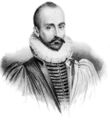Template:Selected anniversaries/February 28: Difference between revisions
No edit summary |
No edit summary |
||
| Line 36: | Line 36: | ||
||1930: Florian Cajori dies ... historian of mathematics. His ''A History of Mathematics'' (1894) was the first popular presentation of the history of mathematics in the United States; even today his 1928–1929 ''History of Mathematical Notations'' has been described as "unsurpassed". Pic. | ||1930: Florian Cajori dies ... historian of mathematics. His ''A History of Mathematics'' (1894) was the first popular presentation of the history of mathematics in the United States; even today his 1928–1929 ''History of Mathematical Notations'' has been described as "unsurpassed". Pic. | ||
||1859: Manuel John Johnson dies ... astronomer. He made the first successful measurement of a stellar parallax, though not to the first publication thereof. Pic search book cover | ||1859: Manuel John Johnson dies ... astronomer. He made the first successful measurement of a stellar parallax, though not to the first publication thereof. Pic search book cover. | ||
||1878: Pierre Fatou born ... mathematician and astronomer. Pic. | ||1878: Pierre Fatou born ... mathematician and astronomer. Pic. | ||
| Line 54: | Line 54: | ||
||1915: Peter Medawar born ... biologist and immunologist, Nobel Prize laureate. | ||1915: Peter Medawar born ... biologist and immunologist, Nobel Prize laureate. | ||
||1921: Pierre Clostermann born ... pilot, engineer, and author. | ||1921: Pierre Clostermann born ... pilot, engineer, military officer, and author. Pic. | ||
||1925: Richard Dalitz born ... physicist known for his work in particle physics. Dalitz's thesis demonstrating that the electrically neutral pion could decay into a photon and an electron-positron pair, now known as a Dalitz pair. In addition, he is known for other key developments in particle physics: the Dalitz plot and the Castillejo–Dalitz–Dyson (CDD) poles. Pic search | ||1925: Richard Dalitz born ... physicist known for his work in particle physics. Dalitz's thesis demonstrating that the electrically neutral pion could decay into a photon and an electron-positron pair, now known as a Dalitz pair. In addition, he is known for other key developments in particle physics: the Dalitz plot and the Castillejo–Dalitz–Dyson (CDD) poles. Pic search. | ||
||1925: The Charlevoix-Kamouraska earthquake strikes northeastern North America. | ||1925: The Charlevoix-Kamouraska earthquake strikes northeastern North America. | ||
| Line 93: | Line 93: | ||
||1993: The Bureau of Alcohol, Tobacco and Firearms agents raid the Branch Davidian church in Waco, Texas with a warrant to arrest the group's leader David Koresh. Four ATF agents and six Davidians die in the initial raid, starting a 51-day standoff. | ||1993: The Bureau of Alcohol, Tobacco and Firearms agents raid the Branch Davidian church in Waco, Texas with a warrant to arrest the group's leader David Koresh. Four ATF agents and six Davidians die in the initial raid, starting a 51-day standoff. | ||
||1996: Bruno von Freytag-Löringhoff dies ... philosopher, mathematician and epistemologist. He was also a university lecturer at the University of Tübingen. During World War II, Freytag-Löringhoff worked as a mathematician in the In 7/VI, that was the signals intelligence agency of the Wehrmacht and worked with Fritz Menzer on the testing of cryptographic devices and procedures. Freytag-Löringhoff worked specifically on the testing of the m-40 cipher machine. His most important contributions to the history of logic and mathematics was his studies and descriptions from 1957, of the calculating machine, built by Wilhelm Schickard. Pic. | |||
||1997: GRB 970228, a highly luminous flash of gamma rays, strikes the Earth for 80 seconds, providing early evidence that gamma-ray bursts occur well beyond the Milky Way. | ||1997: GRB 970228, a highly luminous flash of gamma rays, strikes the Earth for 80 seconds, providing early evidence that gamma-ray bursts occur well beyond the Milky Way. | ||
| Line 104: | Line 106: | ||
||2013: Donald A. Glaser dies ... physicist and biologist, Nobel Prize laureate. Bubble chamber. Pic. | ||2013: Donald A. Glaser dies ... physicist and biologist, Nobel Prize laureate. Bubble chamber. Pic. | ||
||2014: Lee Lorch dies ... mathematician and activist. Pic search | ||2014: Lee Lorch dies ... mathematician and activist. Pic search. | ||
File:Burglars excerpt 1.jpg|link=Burglars (Gnomon Chronicles)|2017: Steganographic analysis of [[Burglars (Gnomon Chronicles)|excerpt from "Burglars"]] unexpected reveals "at least half a gigabyte of encrypted data, probably related to the [[ENIAC (SETI)|ENIAC program]]". | File:Burglars excerpt 1.jpg|link=Burglars (Gnomon Chronicles)|2017: Steganographic analysis of [[Burglars (Gnomon Chronicles)|excerpt from "Burglars"]] unexpected reveals "at least half a gigabyte of encrypted data, probably related to the [[ENIAC (SETI)|ENIAC program]]". | ||
</gallery> | </gallery> | ||
Revision as of 18:26, 22 April 2020
1533: Philosopher and author Michel de Montaigne born. He will be one of the most significant philosophers of the French Renaissance, known for popularizing the essay as a literary genre.
1552: Clockmaker and mathematician Jost Bürgi born. He will be recognized during his own lifetime as one of the most excellent mechanical engineers of his generation.
1901: Chemist, biochemist, peace activist, author, and educator Linus Pauling born.
1961: Codebreaker, historian, academic, and alleged time-traveller Florence Newman Trefethen discovers new class of Gnomon algorithm functions which use high-energy literature sensors to analyze the form and function of poetry.
2017: Steganographic analysis of excerpt from "Burglars" unexpected reveals "at least half a gigabyte of encrypted data, probably related to the ENIAC program".




